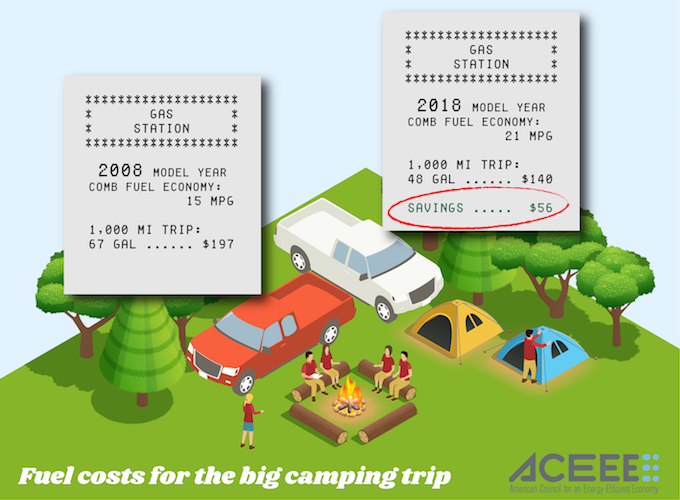A near-record number of families are hitting the road over Memorial Day weekend, just as gas prices are projected to climb to a four-year high. Watching prices creep upward is bringing back painful memories for many Americans, but improved fuel economy is making road trips more affordable than before.
We last saw summer gas prices rise above $3 per gallon at the height of the recession in 2008, when average vehicle fuel economy was only 21 miles per gallon (MPG). This time around, the economy is stronger and vehicles are markedly more fuel efficient, meaning families today are better prepared for higher fuel costs despite the resurgence in popularity of trucks and sport utility vehicles (SUVs). In fact, average model year 2017 fuel economy is expected to exceed 25 MPG, with more-efficient options available in every vehicle segment. The resulting fuel savings can be quite substantial, as we demonstrate with one of the most popular vehicles sold: the Ford F-150.
In model year 2008, the most-efficient four-wheel-drive F-150 had a rated fuel economy of 15 MPG. Today, a similar F-150 gets 21 MPG — a whopping 40% improvement. The savings are impressive: for every 1,000 miles driven, a 2018 F-150 would use 19 fewer gallons of gas than the 2008 model (more than enough fuel savings offset the 28% hike in gas prices we’ve seen since last Memorial Day).
In other words, a roundtrip cross-country road trip in a F-150 — from D.C. to Yosemite National Park, for example — would cost $320 less. And if gas prices creep up further, the savings become even more substantial.
This comparison demonstrates the real-world benefits of increased fuel economy: guaranteed savings at the pump and a smaller impact on families’ budgets when gas prices rise. We use the F-150 example because of its sheer popularity, but nearly all new mainstream cars, trucks, and SUVs offer substantial savings over the older models they replace. Plus, it isn’t just owners of brand new vehicles who benefit from fuel economy standards. Fuel economy has been steadily improving for almost a decade, and more-efficient vehicles have since become widely available in the used car market. You can easily explore vehicle options at greenercars.org and calculate your own potential fuel savings with the vehicles of your choice using the fueleconomy.gov trip calculator.
It’s a good time to remember that fuel economy gains of this magnitude wouldn’t occur without fuel economy standards. But those very standards are now at risk despite their enormous benefits. Under the standards currently in place, a full-size pickup truck meeting model year 2025 fuel economy requirements would average more than 26 MPG, saving $83 and 28 gallons of gas for every 1,000 miles driven, as compared to the 2008 model.
Without the standards, drivers will spend more money at the pump for years to come and will be more vulnerable to fluctuating gas prices. But with consistent fuel economy gains spurred by the standards, families will pay less to take advantage of America’s expansive highways and rich variety of destinations on a good, old-fashioned road trip.
Correction (7/10/18): The graphic in this blog post has been updated with revised numbers for the 2008 model year gallons of gas, 2008 model year fuel cost, and 2018 fuel cost savings.



